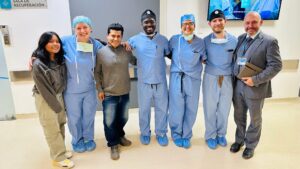The paper introduces an innovative technique for selectively removing endothelial cells from arteries in the perfused rat hind-limb preparation. This method overcomes the limitations of traditional approaches, which often caused non-specific damage to vascular structures. The study developed a protocol involving high flow, followed by the controlled introduction of air bubbles, and concluded with another high-flow phase. This sequence effectively removes the endothelial layer in larger arteries while preserving the integrity of smaller vessels like arterioles, capillaries, and smooth muscle cells.
In the experimental setup, Wistar rats were anesthetized, and their hind limbs were perfused with an oxygenated Krebs-Ringer bicarbonate solution. The perfusion protocol involved a rapid increase in flow rate for two minutes, followed by the introduction of air bubbles over five minutes, and concluding with another two-minute high-flow phase. This high flow/air bubble/high flow method was designed to selectively denude larger arteries, such as the femoral artery and those supplying the extensor hallucis proprius muscle, of endothelial cells while sparing smaller vessels.
Electron microscopy provided detailed insights into the protocol’s efficacy. It revealed that endothelial cells in the femoral artery were either completely removed or severely damaged. In contrast, the smooth muscle cells and the lamina elastica interna remained intact. Importantly, the smaller arterioles and capillaries exhibited no detectable morphological changes, demonstrating the specificity of the method. This selective removal is crucial for studying the distinct roles of endothelial cells in vascular physiology without compromising the viability of the surrounding tissue.
To assess the functional impact of endothelial removal, the study used a,β-methylene ATP, a vasoconstrictor that acts directly on smooth muscle cells via P2x-purinoceptors. Results showed enhanced contractile responses to the vasoconstrictor after endothelial removal, reflected by a leftward shift in the dose-response curve. This amplification underscores the regulatory role of the endothelium in modulating vascular responses and confirms the absence of the endothelial barrier.
Notably, the protocol maintained the overall viability of the vascular bed, as evidenced by unchanged conductance measurements (flow/perfusion pressure) before and after endothelial removal. This suggests that the smooth muscle cells and other structural components of the vascular system remained functional and responsive. The graded damage observed along the vascular tree, with larger arteries showing the most significant endothelial loss, further demonstrates the method’s precision.
This technique addresses a gap in vascular research by providing a reliable, minimally invasive approach to studying endothelial cell functions. Unlike traditional methods involving chemical or mechanical disruption, this high flow/air bubble protocol avoids excessive damage to the vascular structure, enabling more accurate investigations of endothelial roles in blood flow regulation, peripheral resistance, and vasoconstrictor responses. The study also highlights the potential applications of this method in disease modeling, where endothelial dysfunction plays a critical role.
By preserving smaller vessels and ensuring the functionality of smooth muscle cells, this approach provides a versatile model for studying vascular behavior under controlled conditions. For example, researchers can explore how endothelial removal affects autoregulation, vascular reactivity, and the interaction between endothelial and smooth muscle cells. The method also opens avenues for examining therapeutic interventions targeting endothelial dysfunction, a hallmark of many cardiovascular diseases.
The findings emphasize the endothelium’s critical role in vascular homeostasis and its influence on responses to external stimuli. The absence of the endothelium amplifies the effects of vasoconstrictors, shedding light on how endothelial cells act as a barrier and regulator. This information is particularly relevant for understanding conditions like hypertension, where endothelial dysfunction contributes to increased vascular resistance.
In conclusion, the high flow/air bubble/high flow protocol represents a significant advancement in vascular research. It offers a precise, reliable method for selectively removing endothelial cells while preserving the overall structure and functionality of the vascular bed. This technique is poised to become a valuable tool for studying endothelial contributions to vascular physiology and pathophysiology, enabling deeper insights into the mechanisms underlying vascular health and disease.







